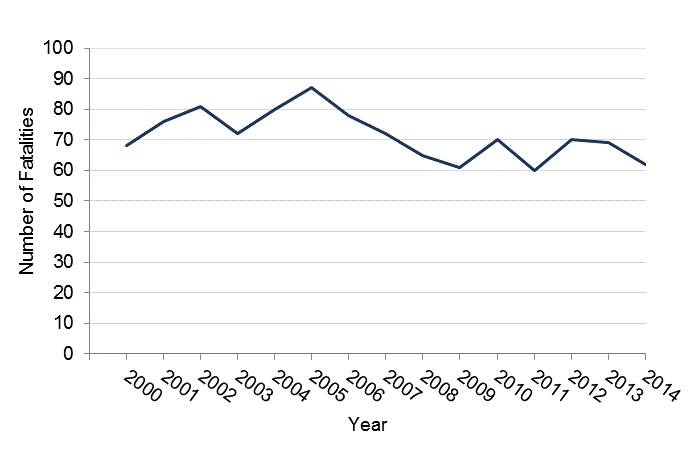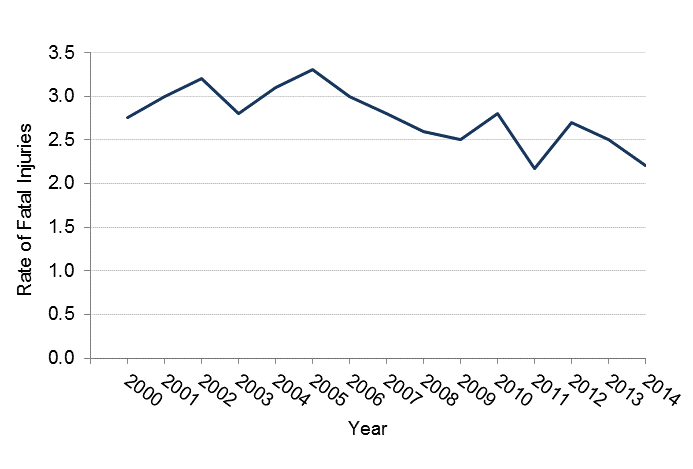Fatal Work-Related Injuries
This indicator tracks fatal work related injuries. Fatalities due to work-related injuries are devastating both for the family of the deceased and the workplace and entail a huge economic burden. It has been estimated that the total medical and indirect costs of fatal work-related injuries and diseases in 2007 were over $50 billion in the U.S. Monitoring of rates and trends of work-related deaths serves as a critical tool in identifying new hazards and evaluating health and safety practices to prevent fatal injuries in the workplace.
The Census of Fatal Occupational Injuries (CFOI)—conducted annually by the Bureau of Labor Statistics (BLS)–compiles data on all fatal work-related injuries in the U.S. The CFOI cross references a number of sources: death certificates, workers’ compensation reports, and federal and state agency administrative reports to compile as complete a list as possible of all occupationally related fatal injuries that occur in the United States. The CFOI is a cooperative program between the states and the federal government and has been operational since 1992.
In 2014 the CFOI identified 4,821 deaths in the U.S. as a result of a work-related injury. The 2014 total was the highest annual total recorded since 2008. This is particularly concerning as work-related injuries should be completely preventable. At the national level, agriculture and construction were the industries with the highest rates, together accounting for 30% of all fatal injuries. Occupational groups with high rates of fatality in 2014 included transportation, construction, installation and maintenance, and farmers and ranchers. About one-fourth of all occupational fatalities in the United States involved workers in transportation and material moving operations.
Of the 62 fatal injuries that occurred in Minnesota in 2014, 97% involved males, 40% involved transportation incidents, 23% occurred due to contact with objects or equipment, 13% were due to an assault or a violent act, 15% were due to falling, and 8% were due to exposure to a harmful substance or environment. Industries with the highest rates of deaths included agriculture (21 deaths) and trande, transportation, and warehousing (18 deaths). Rates of fatal work-related injuries in Minnesota have remained fairly consistent over the past decade. The greatest number occurred in 2005 with 87 fatalities and the lowest occurred in 2011 with 60 recorded fatalities. In 2014 the rate of fatal injuries per 100,000 full-time employees was 2.2 in Minnesota, below the national rate of 3.4 fatal injuries per 100,000 full-time equivalent workers.
The following figures depict the numbers and rates of fatal work-related injuries that occurred in Minnesota between 2000 and 2014.
Number of Fatal Work-Related Injuries in Minnesota, 2000-2014

Rate of Work-Related Fatalities per 100,000 Employed Persons Age 16 Years and Older in Minnesota, 2000-2014

Trend analysis of this indicator from 2000 to 2014 demonstrates a significant decline in the rate of work-related fatal injuries. Continued surveillance and efforts to reduce and prevent hazardous workplace situations and exposures are necessary to ensure this decline continues.
Number and Rate of Work Related Fatalities in Minnesota, 2000-2014
| Year | Number | Fatality Rate per 100,000 employed persons, age 16 and older |
|---|---|---|
| 2000 | 68 | 2.8 |
| 2001 | 76 | 3.0 |
| 2002 | 81 | 3.2 |
| 2003 | 72 | 2.8 |
| 2004 | 80 | 3.1 |
| 2005 | 87 | 3.3 |
| 2006 | 78 | 3.0 |
| 2007 | 72 | 2.8 |
| 2008 | 65 | 2.6 |
| 2009 | 61 | 2.5 |
| 2010 | 77 | 2.8 |
| 2011 | 60 | 2.2 |
| 2012 | 70 | 2.7 |
| 2013 | 69 | 2.5 |
| 2014 | 62 | 2.2 |